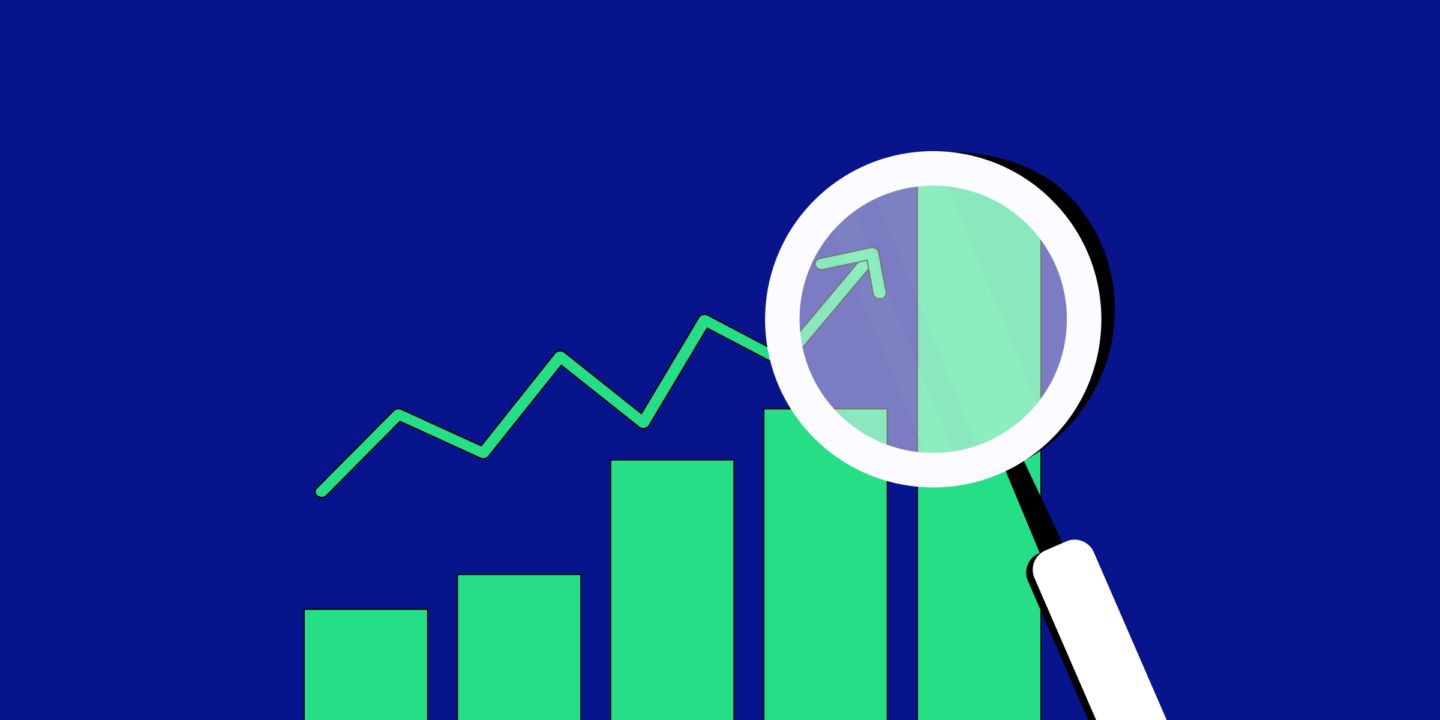
When in doubt, zoom out.
This is a famous quote applicable to pretty much everything in life. I hypothesize that it originated from the trading community, where you look at the bigger picture by increasing the timeframe of your analysis. Ever wondered how some of the pro traders always make money irrespective of the market sentiment? Want to join the party? Well, you are at the right place. Today, I unleash one of the most important skills of a trader, reading charts. And it would just be unfair if I didn’t teach you how to read crypto charts specifically.
Isn’t it just magical how someone can use different time-tested methodologies to predict the movement of the market in the short term? No! It’s not. It is pure science with a tinge of art. And today, it’s time you kickstart your journey as an artist. Read on as I take you through this step-by-step guide on how to read crypto charts.
What Is a Crypto Chart?
A crypto chart is a graphical representation of the market movement. It tells us the direction of the movement and volumes for different time frames. It is exactly the same charts used by stock traders to decide their next move. The only difference is that this time, they represent a crypto instead of a stock. Crypto charts help traders make smart decisions about the assets they invest in.
Why Chart Reading Is Important for Crypto Investors and Traders?
Are you someone who makes hunch-based decisions and regrets them later? This could have been acceptable in cases where there isn’t sufficient data available to conclude. However, in the case of crypto, these charts should be your go-to mode for deciding the future of the asset you are investing in. There is sufficient infrastructure to feed you with relevant indicators in real-time. Here is why chart reading is important for crypto investors and traders.
1. Timing the market
One key argument against learning the charts is that long-term investors don’t need it. This is not true. Even if you plan to hold an asset for the long term, picking the right entry and exit points can make a lot of difference. It is the alpha you are after. Apart from that, you could always exit and get back in as per the market conditions.
2. Exploiting volatility
While the cryptocurrency market is relatively volatile as compared to traditional asset classes, a proficient trader could leverage this volatility to long and short assets to make money in any condition. This requires a deep understanding of charts and trends.
3. Passive income
Another way to look at this is by dividing your long-term and short-term portfolios. You could hold assets for a longer duration and also trade them separately to generate a regular stream of income purely based on your skill set. So even if you are an investor, a money-making opportunity is always worth a shot.
Important Patterns and Indicators for Crypto Chart Analysis
A chart pattern is a shape formed by the up-and-down movement of the prices. These patterns give an idea of where these prices could go in the future depending on their past behavior. They form the basis of any technical analysis and, depending on the context, tell the trader what could be done next.

The above image is a representation of a typical pattern. There are multiple such parameters that we will discuss in this post.
On the other hand, indicators are mathematical calculations plotted as lines on a chart that reveal the emergence of a pattern, signals, and trends. They are used by a trader to add a layer of validation to emerging patterns.
What Is a Technical Indicator?
Technical indicators are signals produced by the price, volume, and open interest of a cryptocurrency. It is the mathematical pattern derived from historical data to predict the future direction of a cryptocurrency.
A technical indicator is displayed graphically and evaluates volume and price simultaneously. It also gives a hint of investor psychology at any given point to make smarter decisions. Besides simply providing insights, technical indicators also reveal how to profit from a given situation.
Important indicators for crypto technical analysis
Now that we are getting a hang of this, it’s time to get into the nitty gritty of indicators. There are multiple indicators out there that are interpreted differently to predict the future price direction. Let us talk about a few of them in detail:
1. Moving averages
Moving averages is the most commonly used technical indicator for crypto technical analysis. As the name suggests, it simply provides you with the average price of crypto over a specific period. This helps cut down sudden spikes and dips (market noise).
Often, moving averages are viewed over a period of 10, 20, 50, 100, or even 200 days. To give you an example of the kind of insights revealed by moving averages, a 200-day moving average indicates support during an uptrend and resistance during a downtrend.
Say the 200 DMA of Dogecoin is at $0.2.
This would mean during an uptrend, the price would likely bounce back from $0.2 levels. Similarly, it would be hard to cross the $0.2 mark in a downtrend for $DOGE.
Moving averages are further subdivided into three categories.
SMA, or simple moving average, simply adds up the prices on each day and divides it by the number of periods.
WMA or weighted moving average, on the other hand, assigns weights to certain periods. For example, a trader might want to assign a higher weight to recent prices in case of a sudden shift in the market sentiment.
EMA, or exponential moving average, also assigns weights to the recent prices but at a changing rate of increase in weights, i.e. the most recent price will have the highest weightage.
In another example, if the 50-day SMA falls below the 200-day SMA, it is known as the formation of the death cross, indicating a future drop in prices. This is the opposite of a golden cross where 50-day SMA > 200-day SMA.
2. Support and resistance levels
A support level is formed at a price where there is heightened buying interest. Similarly, resistance is formed at a point of maximum selling interest. Therefore it is hard to cross these levels. If a stock is going up, it is likely to come down from its resistance levels and vice-versa.
These levels can be identified by drawing trendlines on the chart. An uptrend line is drawn using a cryptocurrency’s lowest and second-lowest lows in a given timeframe. Levels touching this trendline are seen as support.
As you might have guessed, a downtrend line is drawn by identifying the highest and the second-highest peak in a given period. The prices touching this line are known as resistance levels.
How to use these levels, you ask? Well, usually, traders would buy near the support levels as they indicate increased buying interest. Similarly, they would sell near resistance as the prices are likely to go down from there.
3. On-balance volume indicator (OBV)
OBV, or On-Balance Volume indicator, aims to look at the volumes accompanying the price points. Since crypto markets are heavily driven by volumes, it is a good way of validating a particular trend. OBV will go up and down depending on the volume of the trade.
To use it, one must look at it in unison with the prices. A rising OBV should accompany rising prices to confirm the buying interest. Similarly, falling prices should be accompanied by a falling OBV.
You can calculate OBV by adding the previous day’s OBV to the current day’s volumes if the crypto has closed at a higher price than yesterday. Otherwise, you need to subtract the current-day volumes from the previous day’s OBV in case of a lower closure.
4. Moving average convergence divergence (MACD)
Moving average convergence divergence measures the difference between 12-day EMA with 26-day EMA. Based on this, the MACD line is drawn on the chart, which can then be used to get buy or sell signals.
For example, when a 12-day EMA crosses 26-day EMA, it is a sell signal. If we go back to the Moving Averages, it suggests that the prices in the last 12 days have risen sharper as compared to the last 26 days. As a result, the asset might be getting closer to its resistance.
Similarly, if the 12-day EMA is less than the 26-day EMA, MACD indicates a buy signal.
Also, please note that the greater the difference between these two lines on the chart, the stronger the MACD reading.
The indicator also has a signal line, which is a 9-day EMA. The MACD crossing above the signal often implies it’s time to buy, while crossing below it implies it’s time to sell.
5. Relative strength index (RSI)
RSI is an oscillator indicator which means it moves up and down across a line. It is range bound and can move between 0 to 100. This indicates momentum, which measures if a crypto is overbought or oversold.
RSI uses a 14-day timeframe. If the value falls below 30, the asset is considered to be oversold, which means a buy signal. Similarly, if the RSI is beyond 70, the asset is considered to be in an overbought zone which is a sell signal.
6. Bollinger bands
Developed by John Bollinger, Bollinger bands are used to predict short-term price movements by taking the 20-day moving average and either adding or subtracting a standard deviation from it.
Bollinger bands are mainly used to define periods of higher or lower volatility. They are based on the assumption that volatility is cyclic in nature. These bands expand or contract based on the price of the cryptocurrency. If the crypto breaches the upper band, it is considered to be in the overbought zone, and likewise, in the oversold zone if it breaches the lower band.
This indicator is supposed to be used with other indicators to predict the validity of the ongoing pattern. If Bollinger bands separate further during the period of high volatility, it means the ongoing trend is coming to an end. Similarly, when they come closer, high volatility is due for the asset.
What is a candlestick chart pattern?
Candlestick charts are an amazing way to represent multiple pieces of information in a single graph. A typical candlestick chart would carry information like the overall direction of the market, opening price and closing price, and high and low for a specific period.
They are called candlesticks because of the design, which consists of two parts:
Body: Which represents the opening and closing price of the crypto. If the body is red, it indicates that the overall market has fallen in that period, and if it is green, well, you guessed it.
Wick: Wicks are these lines attached to the body. The top wick represents the high, and the bottom wick represents the low.
You can actually set a candlestick chart to any period. For example, if you want to look at a day, a typical chart would have multiple candles, each representing a single day. You could do the same for years, months, hours, etc.
Compare this with a conventional line diagram chart. It would be chaotic to pack so much information in that space.

Important patterns for crypto technical analysis
With indicators out of the way, it is time to dive deeper into the patterns. The various shapes made by the price movement help a trader predict the future price direction.
Although multiple patterns can be made by the charts, we shall discuss the key ones in this article. Let’s take each one of them, one by one.
The best part is if you get a hang of how candles work (discussed above), it is easy to figure out these patterns.
1. Hammer candle pattern
A hammer candle is a trend-reversal, bullish candle. This means it is often found after a period of price fall and is denoted by a long wick with a price jump. It’s called a hammer because it looks like one.

If you think hard enough, you will realize that this particular candle does not have an upper wick. This means once the markets opened, the price started rising and continued to do so till the end of the period. Its lowest point was never reached during that period.
2. Head and shoulders
Applying the same logic, this one does not look like your shampoo bottle. Nonetheless, there are strong reasons to name it that. This pattern consists of a head (the lowest price point) and a shoulder (price points closer to that).

A closer look would tell that this is a typical tussle between the bulls and the bears. Both of them are trying to push the asset in their favorable direction and hence the periods of similar looking ups and downs. The Head and Shoulder pattern also indicates a trend reversal. What you see in the image above is a bullish head and shoulder pattern where if the price breaches the neckline, it will initiate a new rally. Can you guess what a bearish head and shoulder pattern would look like?
3. Wedges in crypto charts
Wedges help us predict the traction of a trend in a cryptocurrency. One can easily draw wedges by drawing lines across the high and low points for a particular period. The formation of lower lows signifies a falling wedge. This means that the current rally is losing its momentum.
On the other hand, higher highs indicate the trend reversal from a bearish sentiment.

4. Shooting star candlestick
Unlike the real-world shooting stars where you’d make a wish, this one is a bearish pattern. It is named so because it looks like a constant fall into oblivion. It is represented by a small body which means that price has fallen slightly during the day. But the wicks are large, indicating that the price shot up once but then bears took over, and it closed on a low. This generally indicates a high resistance and the possibility of a further fall.

5. Inverted hammer candlestick
The inverted hammer is the opposite of a shooting star and hence a bullish pattern. It shows that the crypto closed at a high during the period while hitting a significant peak. And this time around, it really looks like an inverted hammer.

This pattern is considered to be a good buy signal during the downtrend. It tells us that there is a definite buying interest, and the prices may start going up from there on.
How to Read Crypto Charts?
I talked about the key indicators and patterns in the crypto charts. However, one should keep in mind that these are more like general price guidelines. There is no hard and fast rule for the markets to stick to these patterns. Therefore, efficient trading requires a lot of practice and experimenting. Remember I called it art? Now you know why.
Also, one must ensure that all these techniques are deployed with context. Make sure you understand what you are evaluating and for what period. And while you are at it, also put in your knowledge of fundamentals, macro and market together. You cannot separate these from one another.
Ideally, you should first analyze a chart, create a strategy and then test it. Once you are through with that, you can start exploring this realm.
Conclusion
Some of the wealthiest players in crypto have made their fortune by trading. I don’t see a reason that stops you from repeating what they did. However, if you are still on the fence, I have yet another way of generating wealth.
And trust me, this one doesn’t require you to go through a steep learning curve. Coin Sets by Mudrex helps you invest in theme-based baskets of crypto. These baskets are managed by experts so that you don’t have to. Go give it a shot now.
FAQs
1. What do the different colors on a candlestick chart mean?
There are two different colors on a candlestick chart. The red color means that the overall price of the asset has gone down during that period, and the green color means that the overall price has gone up i.e. opening price > closing price.
2. What is the difference between a bullish and bearish candlestick pattern?
Bullish candlestick patterns signify an upcoming price surge, while bearish candlestick patterns indicate that the price of the crypto is likely to go down from there. Bullish and bearish in this context refer to the signal. Bearish patterns would recommend selling and vice-versa.
3. What are some common mistakes people make when reading crypto charts?
A few common mistakes while reading crypto charts include the lack of knowledge of crypto and its fundamentals. Some traders believe that they need not understand the nuances of crypto before trading it, which is wrong.
Also, some traders would jump onto complicated trading strategies right after completing the basics. Trading is a skill, and it requires a specific mindset before you reach there.
Other than that, overtrading, using leverage, and short-term thinking are some other ways one could go wrong.
4. How do you know if crypto is bullish?
You can analyze the ongoing trends along with the overall market conditions to find out if the crypto is bullish or not. The presence of a bullish technical pattern, combined with a bullish indicator, would confirm your hypothesis.




